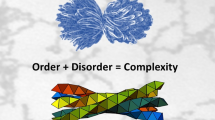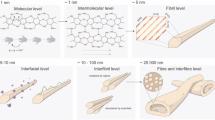Abstract
Cellulose synthase (CESA) molecules are the building blocks and catalytic centers of the CESA complex. The study of mutants in Arabidopsis has led to insight into the structure of these nanomachines. Inside the plasma membrane, the CESA molecules are arranged in complexes, which, apart from the CESA molecules proper, contain other, mostly unidentified, proteins. We developed a theory in which CESA density, together with distance between cellulose microfibrils (CMFs) being deposited and cell geometry, determines wall texture. We have shown earlier how this theory is able to explain the production of axial, helical, helicoid and crossed-polylamellate textures. In the present article we extend this theory to random wall textures.
Similar content being viewed by others
References
Ebskamp M., Akkerman M., Schel J.H.N., Mulder B.M.and Emons A.M.C.2004.The cellulose synthase complex,its structure and assembly,and how its density in the plasma membrane may dictate cell wall texture to appear.To be published.
Emons A.M.C.1989.Helicoidal micro bril deposition in a tip-growing cell and microtubule alignment during tip morpho-genesis:a dry-cleaving and freeze-substitution study.Can.J. Bot.67:2401–2408.
Emons A.M.C.1994.Winding threads around plant cells:a geometrical model for micro bril deposition.Plant Cell Environ.17:3–14.
Emons A.M.C.and Kieft H.1994.Winding threads around plant cells:applications of the geometrical model for micro-bril deposition.Protoplasma 180:59–69.
Emons A.M.C.and Mulder B.M.1997.Plant cell wall archi-tecture.Comments Theor.Biol. 4:115–131.
Emons A.M.C.and Mulder B.M.1998.The making of the architecture of the plant cell wall:how cells exploit geometry. Proc.Natl.Acad.Sci.USA 95:7215–7219.
Emons A.M.C.and Mulder B.M.2000.How the deposition of cellulose micro brils build cell wall architecture.Trends Plant Sci. 5:35–40.
Emons A.M.C.and Mulder B.M.2001.Micro brils build architecture:A geometrical model.In:Molecular Breeding of Woody Plants.Elsevier Science BV, Amsterdam,The Netherlands,pp.111–119.
Emons A.M.C., Schel J.H.N.and Mulder B.M.2002.The geometrical model for micro bril deposition and the influence of the cell wall matrix.Plant Biol. 4:22–26.
Gardiner J.C., Taylor N.G.and Turner S.R.2003.Control of cellulose synthase complex localization in developing xylem. Plant Cell 15:1740–1748.
Haigler C.H.and Brown R.M.1986.Transport of rosettes from the Golgi apparatus to the plasma membrane in isolated mesophyll cells of Zinnia elegans during differentation to tracheary elements in suspension culture.Protoplasma 134:111–120.
Himmelspach R., Williamson R.E.and Wasteneys G.O.2003.Cellulose micro bril alignment recovers from DCB-induced disruption despite microtubule disorganization.Plant J.36:565–575.
Ketelaar T., Faivre-Moskalenko C., Esseling J.J., de Ruijter N.C.A., Grierson C.S., Dogterom M.and Emons A.M.C. 2002.Positioning of nuclei in Arabidopsis root hairs:an actin-regulated process of tip growth.Plant Cell 14:2941–2955.
Ketelaar T., de Ruijter N.C.A.and Emons A.M.C.2003. Unstable factin specifes the area and microtubule direction of cell expansion in Arabidopsis root hairs.Plant Cell 15:285–292.
Lloyd C.and Chan J.2004.Microtubules and the shape of plants to come.Nat.Rev.Mol.Cell Biol. 5:13–23.
Miller D.D., de Ruijter N.C.A., Bisseling T.and Emons A.M.C.1999.The role of actin in root hair morphogenesis: studies with lipochito-oligosaccharide as a growth stimulator and cytochalasin as an actin perturbing drug.Plant J.17:141–154.
Mulder B.M.and Emons A.M.C.2001.A dynamical model for plant cell wall architecture formation.J.Math.Biol.42:261–289.
de Ruijter N.C.A., Rook M.B., Bisseling T.and Emons A.M.C. 1998.Lipochito-oligosaccharides re-initiate root hair tip growth in Vicia sativa with high calcium and spectrin-like antigen at the tip.Plant J.13:341–350.
de Ruijter N.C.A., Bisseling T.and Emons A.M.C.1999.Rhi-zobium Nod factors induce an increase in sub-apical ne bundles of actin laments in Vicia sativa root hairs within minutes.Mol.Plant Microbe Interact.12:829–832.
Sugimoto K., Himmelspach R., Williamson R.E.and Wasteneys G.O.2003.Mutation or drug-dependent microtubule disruption causes radial swelling without altering parallel cellulose micro bril deposition in Arabidopsis root cells.Plant Cell 15:1414–1429.
Wolters-Arts A.M.C., van Amstel T.and Derksen J.1993.Tracing cellulosemicro bril orientation in inner primary cell walls.Protoplasma 175:102–111.
Author information
Authors and Affiliations
Rights and permissions
About this article
Cite this article
Mulder, B., Schel, J. & Emons, A.M. How the geometrical model for plant cell wall formation enables the production of a random texture. Cellulose 11, 395–401 (2004). https://doi.org/10.1023/B:CELL.0000046419.31076.7f
Issue Date:
DOI: https://doi.org/10.1023/B:CELL.0000046419.31076.7f




